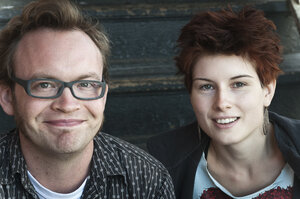Q&A with revised ‘Joy of Cooking’ authors
John Becker and Megan Scott, authors of the ninth edition of “Joy of Cooking,” answer questions about family legacy, cooking technique, and more.

John Becker and Megan Scott wrote the ninth edition of “Joy of Cooking.”
Pableaux Johnson/Courtesy of Scribner
“Joy of Cooking” is a family heirloom in many kitchens, a fundamental guidebook that resonates beyond its recipes. John Becker and Megan Scott, who are husband and wife, understand that family legacy better than most. Mr. Becker is the great-grandson of Irma S. Rombauer, who wrote the original cookbook in 1931. The ninth edition adds historical context, new techniques, and new-to-the-book ingredients – and a sense of responsibility for maintaining the cookbook’s quality and spirit while retaining its relevance. They spoke with Monitor correspondent Rebekah Denn.
Q: Why do people feel such an emotional link to “Joy of Cooking”?
John Becker: I think that a lot of people think of the book as their family. They own it, in a certain way.
Megan Scott: People have a lot of memories around “Joy of Cooking,” and they do inherit them from their loved ones. Especially on Instagram, people will publish their photos of the book and say [things like], “My grandmother gave me this, I’ll remember her through this.” That can be really emotional for us, too.
Q: What’s the book’s personality?
MS: Irma’s foundational approach [was] being a peer or a friend. Not like a teacher or someone telling you what to do, but someone who is there in your kitchen with you who can answer your questions and crack a joke every once in a while.
Q: What went into the revision?
JB: We’ve been working on this book for nine years; over that time we have tested close to 2,000 recipes and developed over 600. ...
We went through the book line by line multiple times and basically questioned everything. Any facts we had any doubt about whatsoever we checked. There are things like the science behind sugar caramelization; the scientific understanding of that has completely changed, and we had to reflect that.
Q: Can you tell me about some of the new sections?
MS: We have a chapter called streamlined cooking. We talk about how to make cooking a practice as opposed to a performance, hoping to convey strategies for becoming a more intuitive home cook. We added a section on fermentation. We added gram weights to the baking chapter.
JB: Our kitchen was covered in different varieties of flour for a good two weeks, but I think it was worth it.
Q: How did you decide to include many new dishes from other cultures?
JB: It wasn’t a struggle; it was more like “How do we make room for these things we’ve been eating?” I’ve been eating Thai and Indian and Vietnamese foods since I was a kid.
MS: They feel very ingrained into American life. They’re not foreign dishes.
[Another addition was] explaining what the ingredients are and why they add such unique flavors and how to include them in your cooking.
Q: What are your favorite recipes?
JB: Plum cake Cockaigne – that recipe has been around since the 1960s. Recently I’ve been thinking a lot about our European borscht. I love that recipe. We’re also getting into cassoulet season and we put that recipe through the wringer. It was
super-involved; we tried to streamline it a bit without turning it into pork and beans.
MS: I am really in love with the olive oil cake recipe, and I love that it can be tailored to any season depending on the fruit you serve it with.

